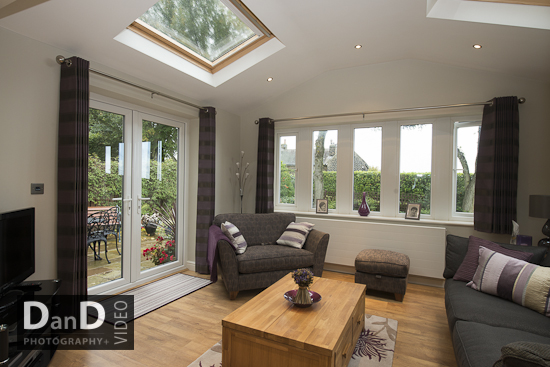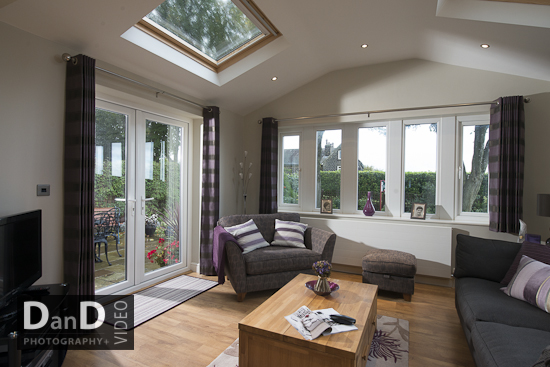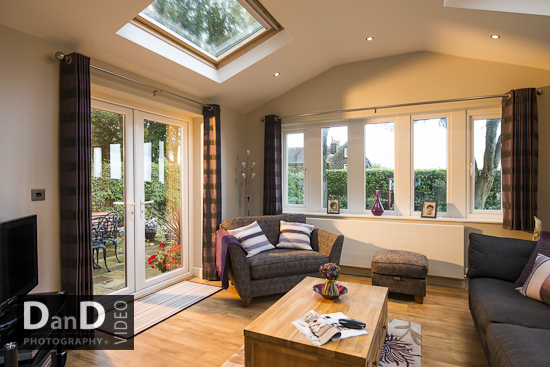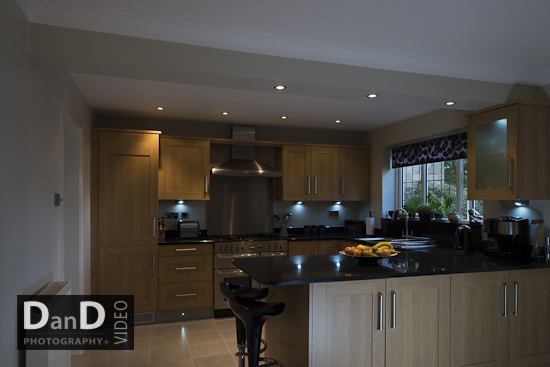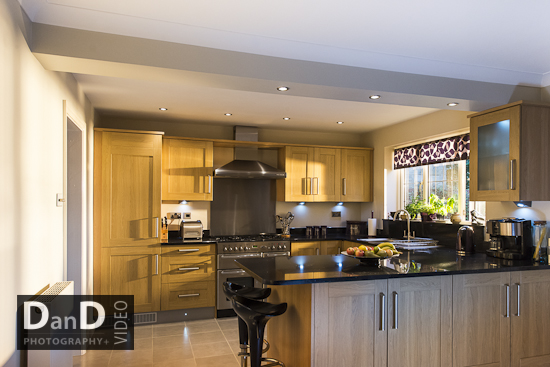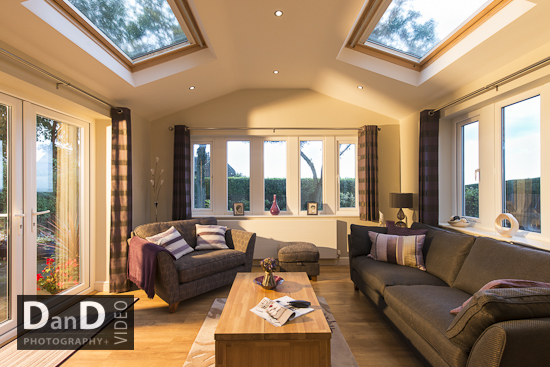
A recent architectural photography assignment found me in deepest West Yorkshire, on a typically dank and dreary winter’s day. The prime mission was residential interiors, so you might think that poor weather shouldn’t really play a part for a job indoors. Well, it does.
I haven’t done one of these types of posts for a while, so fellow photographers may want to read on for a few tips on how to enhance interior scenes and basically ‘fake the sun’. Pay attention at the back.
(If you’re a potential client looking for an architectural and interior photographer, and you’ve stumbled upon this blog post due to the excellent keywording come on in and have a look at the images, then get in touch.)
More after the jump…
Interior photography and ‘faking’ the sun
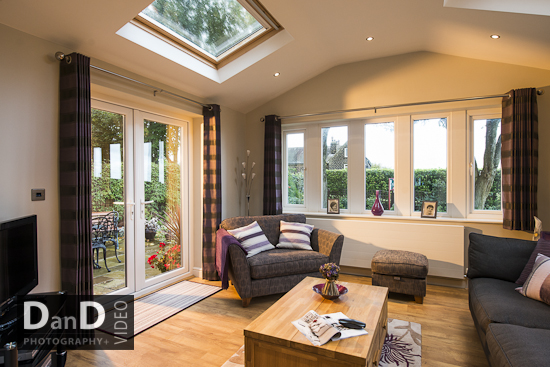
Shot #1
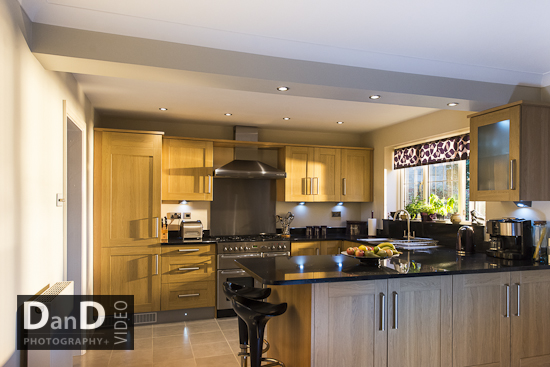
Shot #2
The two shots above look vibrant and bright, warm and welcoming. All homely attributes that any householder (or paying interiors client) would like reflecting in tone and imagery for any residential build.
What is it that’s creating this feeling in these images I hear you ask? Lovely late afternoon sunlight, streaming in through the windows filling the scene with a warm natural glow, right?
Wrong. As mentioned, the sun had not got his hat on and was nowhere to be seen on this day. Both the shots above are 100% artificially lit, and with the right skill, lighting gear, and a few tricks you can get results that look pretty good.
The key to faking the sun for an interior shoot is actually quite simple. You need a big powerful light (obviously), and you need to stick it outside the room, firing in through the windows or patio doors for example.
Something like the Elinchrom Ranger Quadra flash system which I use is perfect, although there are quite a lot of portable and powerful battery powered off camera flash rigs around these days. The Quadra pumps out 400 watts of power from a tiny package, and for these shots it was set to almost max power. One thing for sure – speedlights ain’t going to cut it here, they just don’t have the necessary juice to create the effect, even on a dull Yorkshire day when ambient light levels are low.
Let’s take a quick look at shot 1 in more detail, and how it was constructed. The 3 rotating, annotated images below list the basic camera/ exposure settings and mention when the Quadra was used or not, and whether a coloured gel was used or not….
Gel?
Gel, or coloured gels to be more precise, are something you should experiment with if you’re a photographer who uses off camera flash in their work. I tend to use them quite a lot, mostly with Nikon portable speedlights, for all sorts of assignments (see my Lighting the Lab series of posts on this blog, or my Science portfolio for some good working examples of coloured gels used to the max!)
Often gels are simply used to subtly assist the white balance of a scene if flash is required, but if you push it a bit, or a lot, you can use them to create particular moods or strong effects to really liven up a picture.
Gels come in many colours and ranges, but for the warm afternoon sun effect I’m trying to re-create ‘colour temperature orange’, or CTO is the one to reach for here. It comes in various strengths (full, half, quarter, you get the idea) and as you might expect it warms up the light from a flash when it’s placed on the head.
For speedlights they are nice and small, readily available and fairly inexpensive. However, for my Elinchrom Quadra lights you need something much bigger and for the purposes of faking the sun, I take a more DIY approach and use the type of orange cellophane that flowers come wrapped in, fixed around the quadra head with a laggy band. It’s not technical or particularly glamorous, but it gets the job done.
For this shoot the effect was actually a bit too strong and the amount of orange light flying around was overpowering the scene (a bit like the set of that ‘Essex shit’ TV programme, I should imagine).
Here’s where another tip comes into play – manually adjusting the white balance settings on camera. To help tone down the scene I dialed down the colour temp white balance to around 3200k. This is really ‘cold’ and the image below is how the scene looks at these settings, without the orange gelled quadra/ fake sun firing:
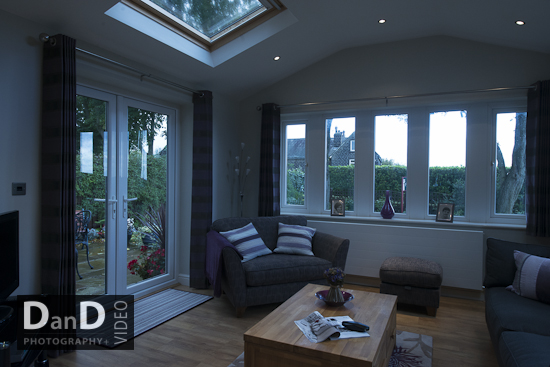
Not very appealing is it? But, you get the idea, and it really demonstrates how the scene was built up with light and fine tuned to get the desired effect as seen in shot #1 when the gelled Quadra, or ‘fake sun’, is powering in through the patio doors at left…

It’s not a perfect image but it’s certainly better then just shooting ambient light on this occasion, and the warming light effect pouring in helps to lift the scene. If you know about your light you might sense that something isn’t quite right though. If you need a clue – the light that can be seen outside the windows and through the skylight is too ‘cold’ so it doesn’t totally work for the scene as a whole. If I had the inclination, (or cash incentive) I might work on this issue more in post production. With a bit of work / lightroom/ photoshop fake sky jiggery pokery I think the exterior could be warmed up and it would be a very nice picture indeed.
To the kitchen
Shot 2 helps to illustrate this issue of ‘cold’ external light further, as here you can’t really see outside the kitchen window on the right as much, and the warm light cascading in is therefore more ‘believable’. The before and after version is in the rotating gallery below…
I should add for this kitchen scene there is other lighting at play, mostly via a shoot through brollied speedlight on the floor at camera right to highlight the counter units and silver handles.
I think the effect of faking the sun is even more dramatic in this image, and you’d be hard pressed to tell if the light powering in through the window was real, or fake. Either way it certainly looks good.
The (shameless) plug
As a working commercial, interior/ architectural photographer ‘real’ or ‘fake’ light doesn’t particularly bother me, it’s the final image that matters. Sometimes, if you’re lucky, you can get away with shooting an interior scene or assignment with ambient light only. More often than not however, a good photographer will build the scene with light step by step to achieve the desired look, and it can take a lot of effort. It’s this effort, knowledge, skill and equipment that you pay for when you commission a pro.
If you are an architectural/ interior design company and would like to promote your services with professional photography, get in touch to discuss the details.
by Dan Dunkley





